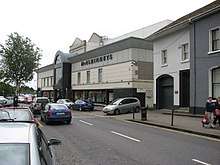Ballybofey
| Ballybofey Bealach Féich | |
|---|---|
 Balor Arts Centre | |
 Ballybofey Location in Ireland | |
| Coordinates: 54°48′00″N 7°47′24″W / 54.8°N 7.790°WCoordinates: 54°48′00″N 7°47′24″W / 54.8°N 7.790°W | |
| Country | Ireland |
| Province | Ulster |
| County | County Donegal |
| Elevation | 30 m (100 ft) |
| Population (2016)[1] | |
| • Urban | 4,852 |
| Time zone | UTC±0 (WET) |
| • Summer (DST) | UTC+1 (IST) |
| Eircode routing key | F93 |
| Telephone area code | +353(0)74 |
| Irish Grid Reference | H194946 |
| Website |
ballybofeystranorlar |
| Historical population | ||
|---|---|---|
| Year | Pop. | ±% |
| 1821 | 1,671 | — |
| 1831 | 1,515 | −9.3% |
| 1841 | 1,167 | −23.0% |
| 1851 | 1,297 | +11.1% |
| 1861 | 1,404 | +8.2% |
| 1871 | 1,349 | −3.9% |
| 1881 | 1,429 | +5.9% |
| 1891 | 1,219 | −14.7% |
| 1901 | 1,203 | −1.3% |
| 1911 | 1,189 | −1.2% |
| 1926 | 1,250 | +5.1% |
| 1936 | 1,198 | −4.2% |
| 1946 | 1,256 | +4.8% |
| 1951 | 1,274 | +1.4% |
| 1956 | 1,586 | +24.5% |
| 1961 | 1,878 | +18.4% |
| 1966 | 1,942 | +3.4% |
| 1971 | 2,214 | +14.0% |
| 1981 | 2,928 | +32.2% |
| 1986 | 2,964 | +1.2% |
| 1991 | 2,972 | +0.3% |
| 1996 | 3,047 | +2.5% |
| 2002 | 3,603 | +18.2% |
| 2006 | 4,176 | +15.9% |
| 2011 | 4,852 | +16.2% |
| [2][3][4][5][6] | ||

Ballybofey (/ˌbæliːbəˈfeɪ/; Irish: Bealach Féich, meaning "Fiach's pass") is a town located on the south bank of the River Finn, County Donegal, Ireland. Together with the smaller town of Stranorlar on the north side of the River Finn, the towns form the Twin Towns of Ballybofey-Stranorlar. Ballybofey-Stranorlar, a census town, had a population of 4,852 in the 2016.[1]
The town grew rapidly in the 19th and 20th centuries. Ballybofey also plays host to the Twin Towns Festival which takes place annually. The centrepiece of the festival is a parade on the Sunday. The last of these took place on 19 August 2007.[7] There are no schools or churches in the town of Ballybofey itself, with all these amenities lying either across the bridge in Stranorlar or outside the town limits. This is due to laws during plantation times when certain Catholic buildings were not allowed within a specified range of Protestant towns, in this case Stranorlar, though Stranorlar now has both a Roman Catholic and a Church of Ireland church.

History
A few miles west of Ballybofey, on the main road to Fintown (the R252), is the Glenmore Estate, located at Welchtown. The estate formerly included Glenmore Lodge, a country house that stood on the opposite, southern bank of the River Finn, near Glenmore Bridge. The house was originally built in the Georgian-style in the mid-to-late-18th-century. It was re-worked for Sir William Styles in the neo-Tudor-style in the early 20th-century. The house was demolished in the 1990s. The private estate is now known for its fishing and hunting.[8]
Sport and leisure
The Balor Arts Centre is an arts and theatre complex, based in Ballybofey, with a 300 seat auditorium. Butt Drama Circle, which celebrated its 50th anniversary in 2009, is an amateur drama club which produces amateur drama productions, and participates in regional and national drama festivals.
Ballybofey is home to Finn Park where League of Ireland side Finn Harps play their home games.[9] Seán MacCumhail Park is also located in Ballybofey, where the Donegal senior football team play most of their home games.
Transport
Ballybofey railway station opened on 3 June 1895, but finally closed on 15 December 1947.[10]
People
- Conal Gallen, singer and comedian
- Ernan McMullin, philosopher
- John Dunleavy, footballer
- Jimmy Kelly, footballer
- Jason Quigley, boxer
- Gerald Porter, darts player
- Isaac Butt born a short distance away in Glenfin, where the Isaac Butt Memorial Hall stands
See also
References
- 1 2 "Sapmap Area - Settlements - Ballybofey-Stranorlar". Census 2016. CSO. 2016. Retrieved 12 January 2018.
- ↑ "Census for post 1821 figures". Cso.ie. Archived from the original on 20 September 2010. Retrieved 18 February 2012.
- ↑ "The Online Historical Population Reports Website". Histpop. Archived from the original on 7 May 2016. Retrieved 18 February 2012.
- ↑ "Northern Ireland Statistics and Research Agency – Census Home Page". Nisranew.nisra.gov.uk. Archived from the original on 17 February 2012. Retrieved 18 February 2012.
- ↑ Lee, JJ (1981). "Pre-famine". In Goldstrom, J. M.; Clarkson, L. A. Irish Population, Economy, and Society: Essays in Honour of the Late K. H. Connell. Oxford, England: Clarendon Press.
- ↑ Mokyr, Joel; O Grada, Cormac (November 1984). "New Developments in Irish Population History, 1700–1850". The Economic History Review. 37 (4): 473–488. doi:10.1111/j.1468-0289.1984.tb00344.x.
- ↑ "Donegal Direct". Donegal Direct. Retrieved 18 February 2012.
- ↑ Rowan, Prof. Alistair (1979). Buildings of Ireland: North West Ulster. London: Penguin Books. p. 564. ISBN 0-300-09667-4.
- ↑ "Finn Harps website". Finn Harps F.C. Retrieved 18 February 2012.
- ↑ "Ballybofey station" (PDF). Railscot – Irish Railways. Archived (PDF) from the original on 26 September 2007. Retrieved 10 September 2007.
External links
| Wikimedia Commons has media related to Ballybofey. |
